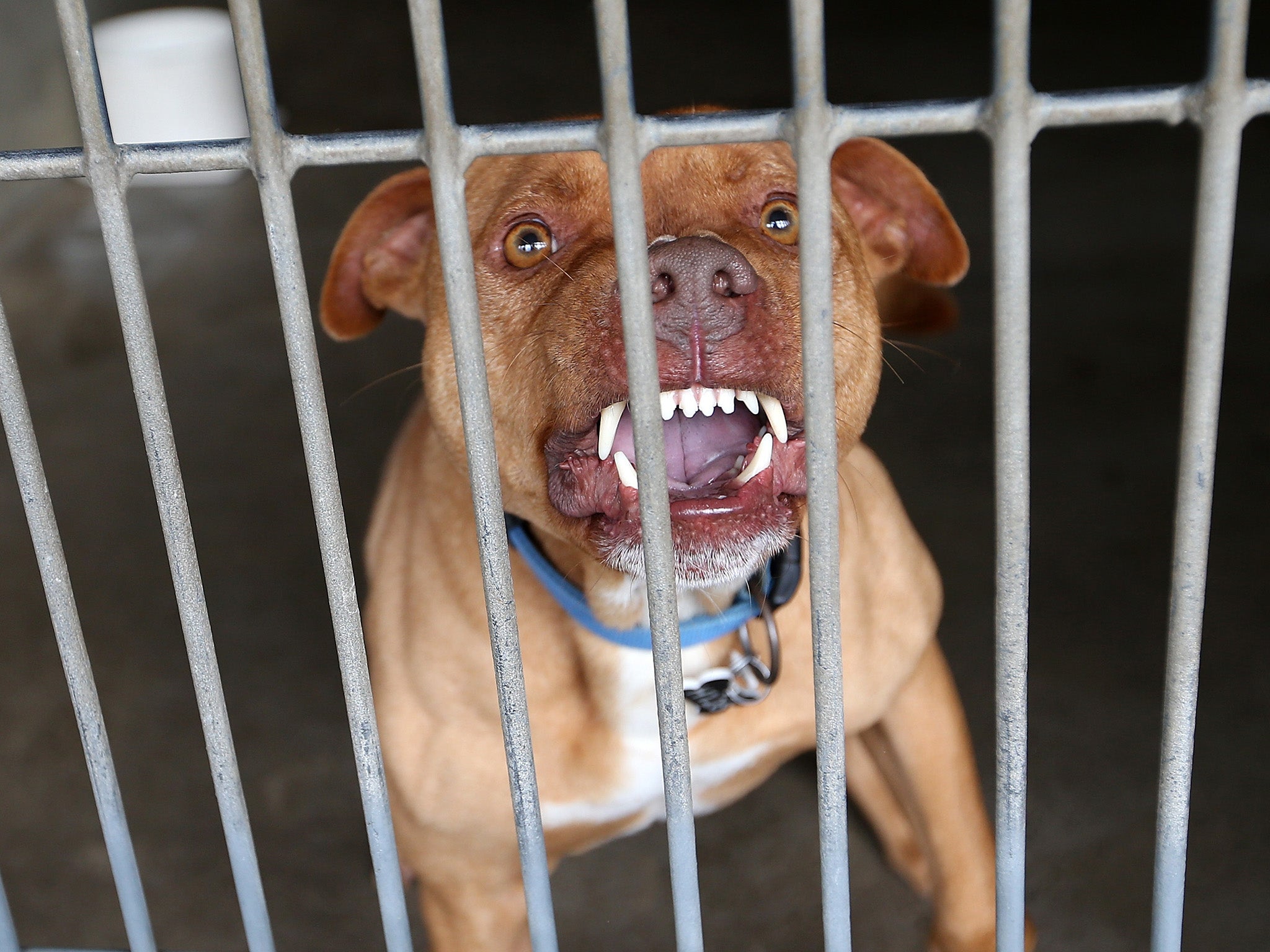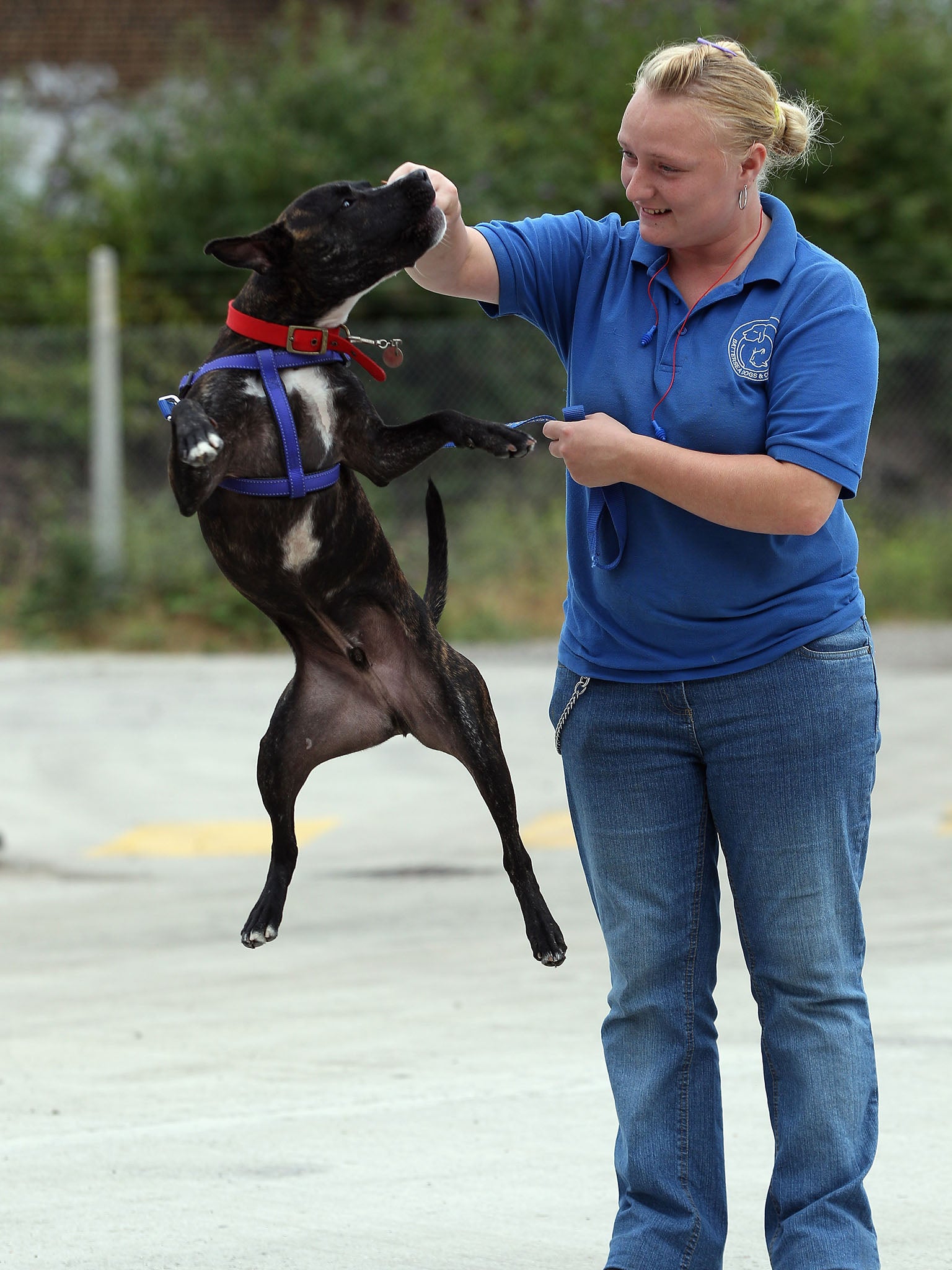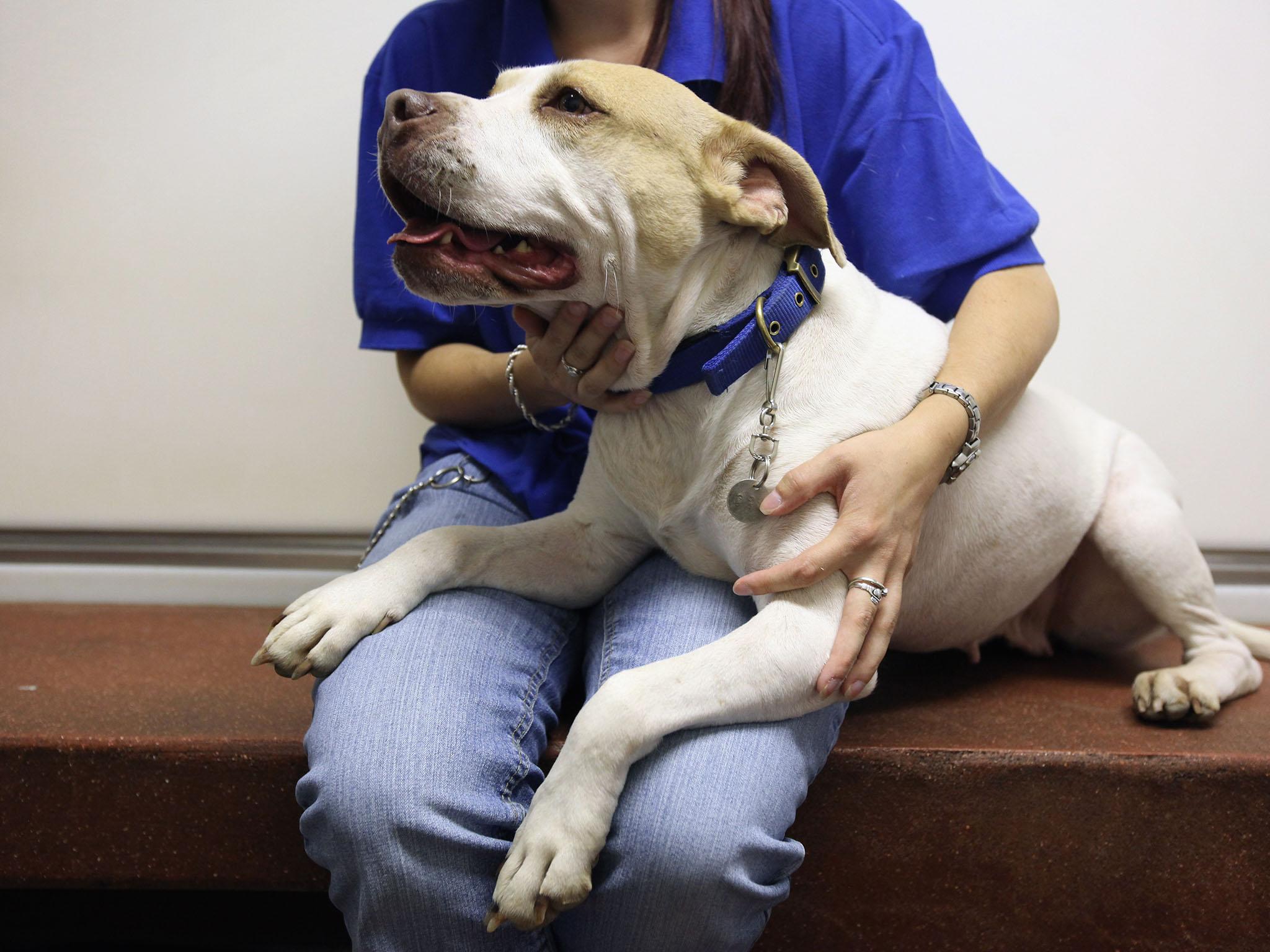Is this dog dangerous? Shelters struggle with live-or-die tests
A standard method for evaluating shelter dogs’ behaviour in the US has come under fire, reports Jan Hoffman. But with the number of people killed by dog bites in the UK nearly tripling over the past 25 years, what is the answer? Marie Carter reports on Britain's treatment of dangerous dogs

Your support helps us to tell the story
From reproductive rights to climate change to Big Tech, The Independent is on the ground when the story is developing. Whether it's investigating the financials of Elon Musk's pro-Trump PAC or producing our latest documentary, 'The A Word', which shines a light on the American women fighting for reproductive rights, we know how important it is to parse out the facts from the messaging.
At such a critical moment in US history, we need reporters on the ground. Your donation allows us to keep sending journalists to speak to both sides of the story.
The Independent is trusted by Americans across the entire political spectrum. And unlike many other quality news outlets, we choose not to lock Americans out of our reporting and analysis with paywalls. We believe quality journalism should be available to everyone, paid for by those who can afford it.
Your support makes all the difference.Bacon, a cream-coloured retriever mix, took a behaviour test recently at an animal shelter here. He flunked.
Bounding into the evaluation room, Bacon seemed like an affable goofball, ready for adoption. But as he gulped down food, Dr Sara Bennett, a veterinary behaviourist, stuck a fake plastic hand attached to a pole into his bowl and tugged it away. Instantly, Bacon lunged at the hand, chomping down on it hard.
Shelters have used this exercise and others for some 20 years to assess whether a dog is safe enough to be placed with a family. For dogs, the results can mean life or death.
“If you failed aggression testing, you did not pass go,” said Mary Martin, the new director of Maricopa County animal shelter in Phoenix, which takes in 34,000 dogs annually. Between January and June 2016, 536 dogs were euthanised for behaviour, most because of test results.
But now researchers, including some developers of the tests, are concluding that they are unreliable predictors of whether a dog will be aggressive in a home. Shelters are wrestling with whether to abandon behaviour testing altogether in their work to match dogs with adopters and determine which may be too dangerous to be released.
In January, Martin stopped the testing. By late June, only 31 dogs had been euthanised for aggression, based on owner reports and staff observations.

“The tests are artificial and contrived,” said Dr Gary Patronek, an adjunct professor at the veterinary medicine school at Tufts, who roiled the shelter world last summer when he published an analysis concluding that the tests have no more positive predictive value for aggression than a coin toss.
“During the most stressful time of a dog’s life, you’re exposing it to deliberate attempts to provoke a reaction,” Patronek said. “And then the dog does something it wouldn’t do in a family situation. So you euthanise it?”
The debate over how dogs should be evaluated arrives as efforts to generally improve outcomes for shelter animals are on an upswing. According to the American Society for the Prevention of Cruelty to Animals, annual adoption rates have risen nearly 20 per cent since 2011 – a period during which owning a “rescue dog” acquired something of a righteous hipness. Euthanasia rates are down, although the ASPCA said 670,000 dogs are put to death each year. Some veterinary schools even offer shelter-medicine specialisations.
Shelters are helped by a burgeoning network of rescue groups. They shuttle dogs from high-kill shelters, usually in the South and Southern California, often to foster homes and adopters in the Northeast and Northwest, where spaying and neutering campaigns have reduced puppy availability.
It is impossible to know how many euthanised dogs scored false positives on behaviour testing. Though rare, false negatives also can occur and have proved tragic. In December, workers at Animal Care Centres of New York City saw nothing remarkable on a standard behaviour test of a dog named Blue, but noted that he had been surrendered for biting a child. A rescue group retrieved him. Blue eventually wound up in a retraining centre in Virginia. On May 31, he was finally adopted; hours later, he attacked and killed a 90-year-old woman.
Some high-volume shelters cannot afford time for evaluations, much less daily walks for dogs; others have begun de-emphasising their significance. Even Emily Weiss, the ASPCA researcher whose behaviour assessment is one of the best-known, has stepped away from food-bowl tests, saying that 2016 research showed that programmes that omit them “do not experience an increase in bites in the shelter or in adoptive homes.”
Still, Jennifer Abrams, head of the behaviour and enrichment staff at Animal Care Centres of New York City, which sees 8,900 dogs a year, said that anxious adopters needed assurances. “People want to know what they’re getting – that a dog won’t bite, yell and scream at other dogs on a leash,” she said.
But predicting an animal’s behaviour belies the nature of dogs, Abrams said: “A dog’s behaviour is based on stimuli in the moment.” Abrams’ team conducts assessments, considering them snapshots, while gathering information throughout the animal’s stay.

In the surge to modernise shelters, tests were an attempt to standardise measurements of a dog’s behaviour. But evaluations often became culling tools. With overcrowding a severe problem and euthanasia the starkest solution, shelter workers saw testing as an objective way to make heartbreaking decisions. Testing seemed to offer shelters both a shield from liability and a cloak of moral responsibility.
“We thought we had the magic bullet,” said Aimee Sadler, a shelter consultant. “’Let’s let Lassie live and let Cujo go.’ From a human perspective, what a relief.”
The 10- to 20-minute tests, developed by behaviourists and tweaked by practitioners, ask two basic questions: Will the dog attack humans? What about other dogs?
Evaluators may observe the dog react to a large doll (a toddler surrogate); a hooded human, shaking a cane; an unfamiliar leashed dog or a plush toy dog.
But these tests have never been rigorously validated.
Bennett’s 2012 study of 67 pet dogs, which compared results of two behaviour tests with owners’ own reporting, found that in the areas of aggression and fearfulness, the tests showed high percentages of false positives and false negatives. A 2015 study of dog-on-dog aggression testing showed that shelter dogs responded more aggressively to a fake dog than a real one.
Janis Bradley of the National Canine Research Council, co-author with Patronek of the analysis published last fall, suggested that shelters should instead devote limited resources to “observing the many interactions that happen between dogs and people in the daily routine of the shelter.”
But Kelley Bollen, a behaviourist and shelter consultant in Northampton, Massachusetts, maintained that a careful evaluation can identify potentially problematic behaviours. Much depends on the assessor’s skill, she added.
In fact, no qualifications exist for administering evaluations. Interpreting dogs, with their diverse dialects and complex body language – wiggling butts, lip-licking, semaphoric ears and tails – often becomes subjective.
Indianapolis Animal Care Services, which admitted 8,380 dogs to its municipal shelter in 2016, is often overcrowded and understaffed, yet faces intense scrutiny to save dogs while protecting the public. Last year it euthanised 718 dogs for behaviour, based on testing and employee interactions. The agency consulted Bennett, a shelter specialist, to better manage that difficult balance.
Even as she demonstrated assessments for staff members, Bennett noted another factor that renders results suspect: the unquantifiable impact of shelter life on dogs.
Dogs thrive on routine and social interaction. The transition to a shelter can be traumatising, with its cacophony of howls and barking, smells and isolating steel cages. A dog afflicted with kennel stress can swiftly deteriorate: spinning; pacing; jumping like a pogo stick; drooling; and showing a loss of appetite. It may charge barriers, appearing aggressive.
Conversely, some dogs shut down in self-protective, submissive mode, masking what may even be aggressive behaviour that only emerges in a safe setting, like a home.
Little dogs can become more snippy. But no matter what evaluations may show, they always seem to get a pass. “I’ll warn, ‘He nips and snarls,’” recounted Laura Waddell, a seasoned trainer who does volunteer evaluations for Liberty Humane Society in Jersey City, New Jersey. “And I get back: ‘I don’t care! I’m in love!’”
One way to reduce kennel stress, Sadler, the shelter consultant, said, is through programmes like hers, Dogs Playing for Life, which matches dogs for outside playgroups. Shelter directors say it is a more revealing and humane way to evaluate behaviour. The approach is used at many large shelters, including in New York City, Phoenix and Los Angeles.
The most disputed of the assessments is the food test. Research has shown that shelter dogs who guard their food bowls, as Bacon did, do not necessarily do so at home.
The exercise purports to evaluate “resource guarding” – how viciously a dog will protect a possession, such as food, toys, people. Common-sense owners wouldn’t grab a dog’s food while it is eating. But shelters worry about children.
Bennett suggested that Bacon’s bite of the fake hand didn’t necessitate a draconian outcome. With counselling, she said, a household without youngsters would be fine.
The shelter workers dearly wanted to save Bacon. But they were so overwhelmed that they did not have the capability to match him appropriately and counsel new owners.
So Bacon remained at the shelter for several weeks, waiting. Finally, Linda’s Camp K-9, an Indiana pet-boarding business that also rescues dogs, took him on. He settled right down and recently was adopted. Linda Candler, the director, placed him in a home without young children, teaching the owners how to feed him so he wouldn’t be set up to fail.
“His potential made him stand out,” Candler said. “Bacon is amazing.”
© New York Times
How Britain treats dangerous dogs, by Marie Carter, editor of Pet’s Magazine
How we treat “dangerous dogs” in the UK is different from the US. Harsh and misleading “provocation” tests are not, thankfully, used routinely here.
Rescue centres are guided by The Dangerous Dogs Act (1991), which has attracted a lot of adverse criticism, largely because its remit was limited to just four banned breeds, the Pit Bull Terrier, the Japanese Tosa, the Dogo Argentino and the Fila Brasiliero. Rescue centres are obliged by law not to rehome any of these four breeds.
New RSPCA figures released this week suggest that since the introduction of the Act, the number of people killed by dog bites has almost tripled. This has resulted in further calls for a greater focus on behaviour rather than breed. Other countries do things better. In Calgary, for example, there is no ban breeds but owners are fined up to $10,000 (£6,000) if their dog attacks someone. This has led to a 50 per cent cut in the number of dog attacks.
Before rehoming can take place, all other dogs are assessed by vets and behavioural experts to determine if they would make suitable pets. Tests tend to consist of observation and interaction and are not focused on “provocation” tests that have been carried out in the US, which are bound, by their very nature, to generate false positives, or even negatives.
Imagine for one moment being an abandoned dog that has maybe been abused or experienced trauma arriving at a strange and very noisy rescue facility, perhaps starving and being offered a bowl of food by a kindly human hand?... Busily eating, a plastic hand (the ‘provocation’ tool of choice in the US) tries to snatch your food, would you not try to stop it? It’s a scandal that in the US thousands of dogs are euthanised each year for behaviour, mostly because of test results. It’s good news that these tests are gradually being abandoned, as they are so unreliable in determining a dog’s real temperament.
Behavioural tests should not involve provocation, but should focus on how well the dog interacts with staff and other dogs. A short fuse may just be initial anxiety and they may calm down as trust builds. If a dog has already attacked someone in their previous life then it should be placed under greater vigilance and questions asked such as how serious was the attack; did it draw blood; was the attack provoked? It should at least be given a chance at a new life. Away from irresponsible owners, an unruly dog may flourish. There are surely bad dogs out there, but many problems are down to bad owners.
Join our commenting forum
Join thought-provoking conversations, follow other Independent readers and see their replies
Comments